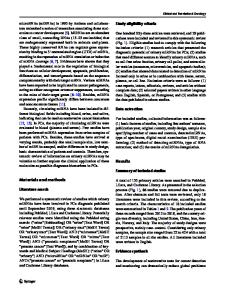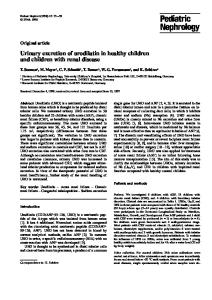Urinary copper/zinc ratio: a promising parameter for replacement of 24-hour urinary copper excretion for diagnosis of Wi
- PDF / 228,382 Bytes
- 6 Pages / 595.22 x 842 pts (A4) Page_size
- 47 Downloads / 227 Views
Urinary copper/zinc ratio: a promising parameter for replacement of 24-hour urinary copper excretion for diagnosis of Wilson's disease in children Jian-She Wang, Yi Lu, Xiao-Hong Wang, Qi-Rong Zhu Shanghai, China
Original article 148
Background: Although 24-hour urinary copper excretion is valuable for diagnosis of Wilson's disease, accurate, timed collection entails practical difficulties. This study aimed to investigate the feasibility of morning urinary copper/creatinine or copper/zinc ratio as replacement parameter for diagnosing Wilson's disease. Methods: Five random urinary samples collected during 24 hours from two inpatients were used to estimate the consistency of urinary copper/creatinine and copper/zinc ratios. The correlation of the ratios with 24-hour urinary copper excretion was studied in 15 patients with liver diseases. The diagnostic value of morning urinary copper/zinc ratio was further studied in 9 children with Wilson's disease and 22 children with other liver diseases. Results: The coefficients of variation of urinary copper/creatinine and copper/zinc ratios during 24 hours were 12.5% and 9.3% respectively. The morning urinary copper/creatinine ratio, copper/zinc ratio, and 24-hour urinary copper excretion were correlated well. The area under receiver-operating characteristic curve was comparable between the morning urinary copper/zinc ratio and 24-hour urinary copper excretion (0.983 vs. 0.977). Conclusion: Morning urinary copper/zinc ratio seems to be a promising parameter in replacement of 24-hour urinary copper excretion for diagnosis of Wilson's disease. World J Pediatr 2010;6(2):148-153
Author Affiliations: The Center for Pediatric Liver Diseases, Children's Hospital of Fudan University; The Department of Pediatrics, Shanghai Medical College of Fudan University, Shanghai 201102, China (Wang JS, Lu Y, Wang XH, Zhu QR) Corresponding Author: Jian-She Wang, MD, PhD, Children's Hospital of Fudan University, 399 Wanyuan Road, Minhang District, Shanghai 201102, China (Tel: +86-21-64931171; Fax: +86-21-64931901; Email: jshwang@ shmu.edu.cn or [email protected]) doi:10.1007/s12519-010-0023-4 ©Children's Hospital, Zhejiang University School of Medicine, China and Springer-Verlag Berlin Heidelberg 2010. All rights reserved.
World J Pediatr, Vol 6 No 2 . May 15, 2010 . www.wjpch.com
Key words: children; urinary copper/zinc ratio; Wilson's disease; 24-hour urinary copper excretion
Introduction
W
ilson's disease (WD), is an autosomal recessive disorder of copper metabolism caused by mutations within the ATP7B gene. This causes impaired biliary copper excretion, resulting in hepatic copper toxicity and subsequent multisystem disease involving the liver, brain, cornea, skeleton and rarely the heart.[1,2] It affects 1 in 30 000 people with fatal outcome if untreated. Early diagnosis is essential because specific treatment can prevent further liver injury and neurological complications in most cases, whereas those with very severe damage require early liver transplantation to prevent a fatal out
Data Loading...











